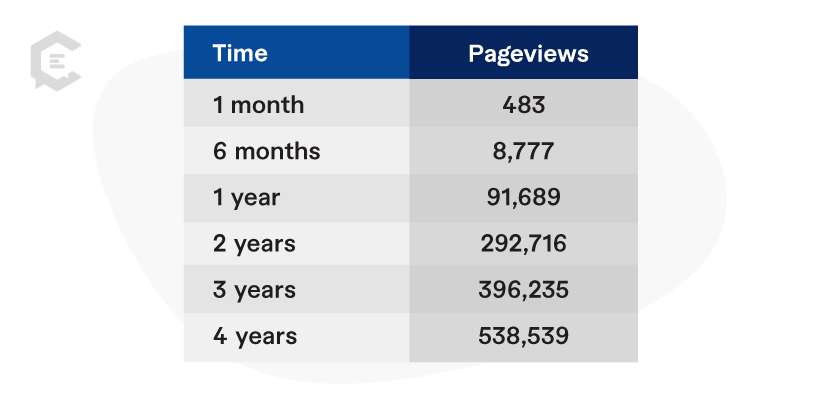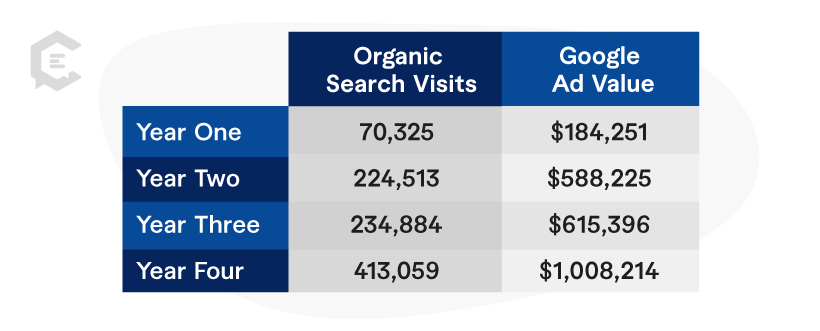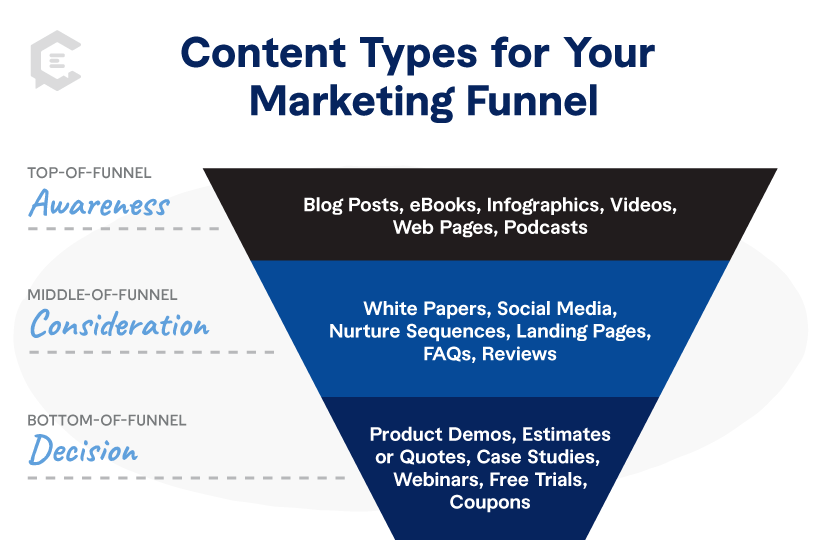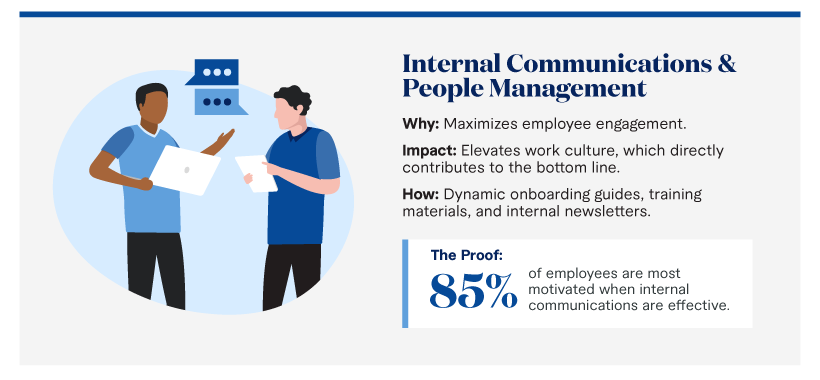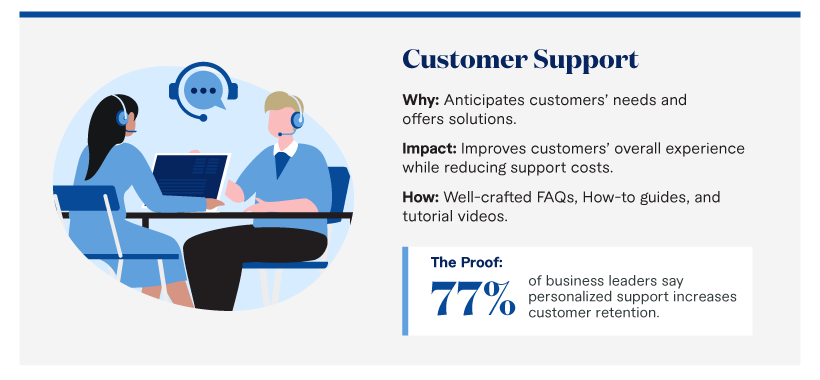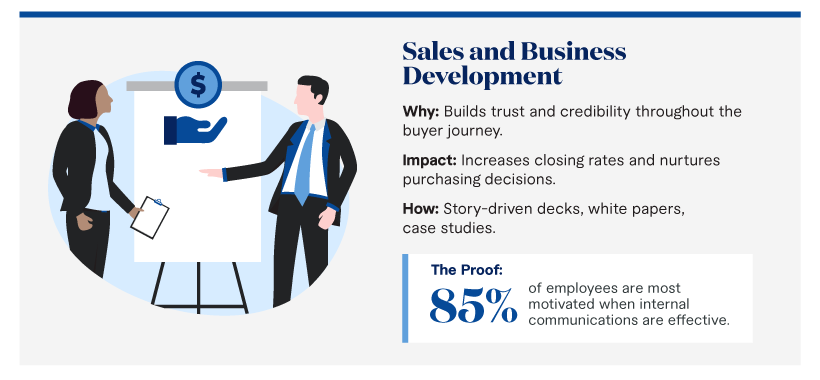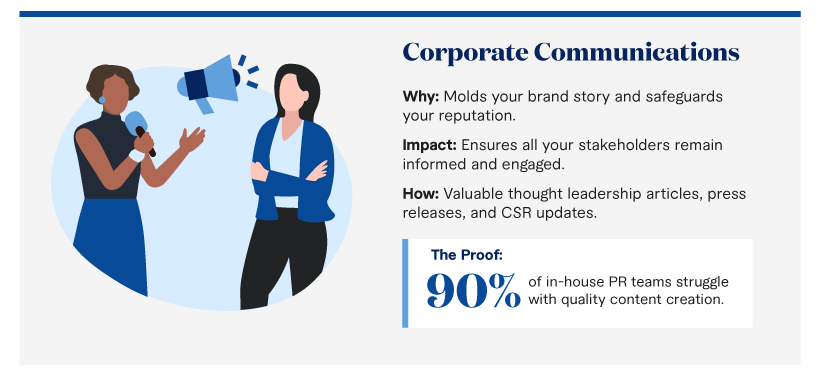At ClearVoice, we understand that not all people are content people. Heck, not all marketing people are content people. So whether you’re here because you’re a content person looking to enhance your business case for more content dollars or because a content person wants you to understand their perspective on why content is (still) queen, you’ve come to the right place.
Let’s start with the business brass tacks. Marketing is the tip of the spear for driving growth and new customer acquisition. Even in mature businesses, it’s tempting to funnel a lot of budget into short-term, paid campaigns for quick wins. Paid is straightforward, it’s sexy (to non-marketing executives, at least), and it’s a simple sell internally when navigating the budgeting process because of the instantly measurable ROI.
We get it! We’ve been tempted to and have poured a ton of dollars into paid before, and we’re a content-led organization that has used content to grow our organic traffic 35X (and counting over the past five years).
But remember one simple truth — with content marketing, you invest once and get a lasting asset base that consistently attracts and engages your target audience and customers alike. As a bonus, leads generated using content versus paid are 6x more likely to convert than other marketing methods, including paid (more on this later).
“Content marketing rakes in conversion rates six times higher than other methods.”
— Content Marketing Institute
Below, we’ll dive into the strategic importance of content marketing within the broader marketing ecosystem and why marketers and business leaders should invest in high-quality content to enhance both organic and paid marketing efforts. Here we go!
The Long-Term Value of Content in Marketing
The Warren Buffet quote, “Someone is sitting in the shade today because someone planted a tree a long time ago,” illustrates the value of content marketing. It’s about earning attention and building trust over time.
Despite a glut of bad content online — increasing daily due to the rise of generative AI — the fact of the matter is that people do value quality content. They want to be informed and educated about brands, products, and services. They want to discover solutions and make purchase decisions without being marketed or advertised. In this way, content is a long play, winning trust over time.
Any business case for content must explore the following:
Alignment with overarching business goals
A case for anything marketing-related must start with a firm understanding of the business goals and how marketing ties into those targets. Now, before you say, ‘Well, of course,’ take a moment and think about all of the marketing campaigns you have in the field right now. Can you immediately tie those into the core metrics of the business?
For example:
Company A spends a tremendous amount of resources running Google pay-per-click campaigns to drive in potential new customers. The business has the following targets:
- # of Qualified Leads: 150 per month
- Close Percentage: 25 percent
- Average Contract Value: $75,000
- NRR: 98 percent
However, while this channel drives many leads, they only close at 15 percent with an ACV of $40,000 and a 94 percent NRR, which is off the mark. Of course, you could evaluate the blended rates for all marketing, but if you’re looking for the best investment by channel, this might be where you throttle back your spending.
Content marketing and producing content presents an additional challenge when building the business case, as not all content activities drive immediate ROI.
Engagement and trust building
Most brands understand that building relationships with existing and potential customers is essential to longevity. Content is the cornerstone of building those relationships on a bigger scale.
Quality content engages readers by providing valuable information, establishing your brand as a trusted resource. It works for the brand even when your team is offline, allowing you to take a 1-to-many approach to sharing your team’s expertise.
Tie your content to metrics that illustrate the importance of engagement and trust in the bottom line. Some examples include:
- Driving Awareness
- Blogs
- Guides
- Social media
- Lead → Customer Conversion
- eBooks & white papers
- Customer stories
- Sales videos
- Email nurture sequences
- Customer Retention
- Help centers
- Interactive webinars
- Customer newsletters
Longevity of content
The value of content extends far beyond the initial investment. Creating a data study or white paper for $10,000 may sound extravagant when that same amount in a paid campaign could drive 20 new qualified leads immediately, but how does that white paper help convert leads into customers by validating your product or service?
Show your fellow business leaders how each piece of content pays dividends over the years. Here’s an example from ClearVoice’s marketing.
One of our top blog posts on ClearVoice had the following performance over its first four years.
The article showed promise at publication, but over the next four years, it drove over half a million page views with no additional investment from our team.
Let’s further break down the dollars and cents.
When your content rises in search ranking and traffic, the ROI increases exponentially over time. For example, with Google Ads – the average CPC for Google Ads as of Q1 2024 is $2.62. If you multiply the average CPC cost by search visits, the ad value is over $1 million.
Impact on SEO and organic discovery
While your business case for content should expand well beyond the SEO, remember to include it here. Potential customers do most of their research online before entering the sales funnel, and while the exact percentage varies from research study to research study, somewhere between 71 percent and 92 percent of B2B buyers start with a generic search. This means shoring up your search visibility is critical.
The good news is your team can do effective SEO without producing hundreds of blogs and building a massive content ecosystem. It requires consistently publishing informative and relevant content that addresses your target customers’ interests, pain points, and comment questions related to your service.
Finally, when talking to other decision-makers about top-of-funnel content designed for search, be ready to showcase why ‘just using AI’ won’t cut it. Generative AI is a valuable tool that helps with ideation, some initial drafting, and editing, but creating content for humans by humans is critical. Outline the value of Google’s E-E-A-T algorithm and why showcasing expertise is vital for content success. Not sure what that is? Read more about what is Google’s E-E-A-T algorithm.
Synergy with other marketing channels
Content marketing isn’t a standalone strategy; it complements and enhances other marketing efforts, from email marketing to social media, creating a cohesive brand narrative. In fact, as you’re building out various campaigns, you’ll need to create content to ensure they are also successful.
For example:
Paid advertising
- Landing pages: Increase conversions by tying together the creative from the ad copy to the thank you page. Content can provide deeper insights and helpful information that encourages someone to purchase or request more information.
- Sponsored content: Develop sponsored articles that align with the theme of your paid campaigns. These pieces are more informative and less salesy than traditional advertising.
Social media
- Narrative, value-driven posts: For millennia, humans have connected through stories regardless of the medium. Invest in producing higher-quality social content to boost engagement.
- User-generated content: UGC also requires an investment — from curating to repurposing. But it’s worth it as this approach provides authentic content for your brand by letting your customers speak for you.
Email marketing
- Value newsletters: Email is one of the most valuable channels you can own. Expand your relationship with your subscribers by providing content of value versus a series of promotions.
- Personalized content: Tailored content increases relevance and potential conversions. Use data from your email platform to personalize your emails to different audience segments.
Partnership marketing
- Co-created content: Leverage the audience and credibility of your partners by collaborating on co-branded content such as webinars, whitepapers, or joint blog posts.
Brand authority and thought leadership
It may seem like everyone wants to be a thought leader today, but this doesn’t mean putting out any old content will do. A whopping 64 percent of B2B buyers report “that an organization’s thought leadership content is a more trustworthy basis for assessing its capabilities and competency than its marketing materials…”
Think about companies that took a position on something — HubSpot on Inbound Marketing, Drift on Conversational Marketing, and 6Sense on Account-based Marketing. They grew their brand from the content and conversations they were sparking where their customers live online.
Also, remember that at any given time, only about 9-11 percent of your total addressable market wants to buy in a given quarter. Regularly publishing insightful content positions your brand as an industry thought leader, enhancing credibility and authority in your field while keeping you top of mind for when the business is ready to buy your product or service.
Increased social sharing and virality
Gone are the days of the CEO bellowing, “How do we go viral?” from their office (we hope for your sake, anyway). Nowadays, marketers focus on compelling content that other thought leaders and influencers want to curate for their followers. In B2C, this might be a funny video that gets stitched over and over. In B2B, this looks like an industry leader calling out a recent article or post from your company.
Investing in content with a perspective written by expert writers and amplified via social networks significantly boosts brand visibility and engagement. It also adds a layer of credibility from others in the industry whose opinions your target customers value.
Lead generation and nurturing
Savvy marketers guide customers through the buying journey, from awareness to consideration to the decision stage, using high-quality content that informs instead of sells. Your content business case should explain why your content budget must produce assets for the entire sales funnel (and beyond).
Content types for your marketing funnel
Each piece of content you create has a unique purpose in your marketing funnel. Let’s break down which content types should go where.
- Top-of-funnel: Awareness
- Blog posts
- eBooks
- Infographics
- Videos
- Web pages
- Podcasts
- Middle-of-funnel: Consideration
- White papers
- Social media
- Nurture sequences
- Landing pages
- FAQs
- Reviews
- Bottom-of-funnel: Decision
- Product demos
- Estimates or quotes
- Case studies
- Webinars
- Free trials
- Coupons
Differentiation from competitors
Ask yourself this: How many competitors are in my market? Then ask: How is my company different? You may have a firm grasp on your unique value propositions and incorporate those into the sales talk track, but what other ways can you amplify them online? Yes, through content, and it can look so many different ways!
To name a few:
- Blogs addressing your customers’ questions in a unique way
- Comparison landing pages showcasing how you stack up against a competitor
- Customer stories illustrating how your results are superior to other options in the market
- White papers and eBooks providing in-depth perspectives about an industry hot topic
Enhancing customer experience and loyalty
Content marketing continues even after the agreement is signed. Once a company becomes a customer, now is the time to provide additional value by sharing helpful information, answering questions, offering solutions, and more to add value beyond the product or service.
Here’s some data that will make you lean in:
- 97 percent of customers say their customer experience impacts whether they stay loyal to a brand
- 72% of global customers feel loyalty toward at least one brand or company
- 59% of Americans say once they’re loyal to a brand, they’re loyal to it for life
Great content unlocks a long-term relationship rather than an immediate transaction. By consistently providing valuable experiences post-sale, you position yourself as a trusted partner they can turn to for solutions. Show customers that you’re invested in their success, and they will be loyal in return.
At ClearVoice, the marketing and customer success teams partner on customer-focused written and experiential content designed to nurture the partner and turn buyers into repeat customers and, hopefully, brand advocates.
Feedback and community building
When done right, your content will open a door for feedback and community engagement, allowing brands to build a loyal community of followers who contribute to and advocate for the brand.
Plus, you’re killing two birds with one stone. You’re giving your audience a voice and nurturing their sense of belonging while getting valuable insights into their preferences and needs. You can then use those insights to refine your content to drive engagement and maximize its impact, further developing communal bonds.
Focusing on these critical elements makes the business case for content clear: it’s an investment in building a lasting, trustworthy relationship with your audience, driving growth, and establishing a strong market presence.
Content Production Beyond Marketing: Integrating Content Throughout Your Business
Okay! We broke down why investing in content is critical for marketing, but what about the rest of your business? It’s easy to think that content is confined to the creative types, but we’re here to tell you that every team — from people (human resources) to product are served by a healthy company-wide content apparatus.
Philosophically, a holistic approach to content is not just about breaking down silos; it’s about building bridges — bridges of knowledge, collaboration, and shared purpose. Integrating content cross-departmentally doesn’t just add value; it transforms operations, strategies, and even company culture.
Let’s explore:
Internal communications & people management
Whether it’s sleek internal newsletters or training materials that pop, the right content as part of your internal engagement and employee onboarding not only ensures a happier work culture but can directly contribute to the company’s bottom line.
Look at ‘Content’ as the sixth C of the 5 Cs strategy for employee engagement: Care, Connect, Coach, Contribute, and Congratulate. Content is the delivery mechanism to make the most of each of these strategies.
Remember that first impressions are crucial. Most companies focus on customers and leave their employees with less-than-ideal experiences that leave lasting impressions and potentially impact long-term retention negatively. 85% of employees are most motivated when internal communications are effective. Things like dynamic onboarding guides, training materials, and internal newsletters maximize employee engagement and elevate work culture, which directly contributes to the bottom line.
With thoughtful content experiences, you lay the groundwork for a more positive and lasting relationship with your employees.
Product development
This stat blew our minds: 89 percent of new products fail in the market within their first five years due to a lack of customer understanding.
Here, your content takes on the role of detective, helping create a dynamic and continuous dialogue with your audience that ensures you understand their needs, preferences, and aspirations. Generating key audience insights and feedback loops will help inform your product roadmap and support R&D.
Customer support
Taking a content-forward approach in your customer support will elevate your brand, save you money and resources, and even drive business growth in the long run.
- 77 percent of business leaders say personalized customer support leads to increased customer retention.
- 80 percent of customers say the experience a company provides is as important as their product or service.
- 93 percent of customers are likely to repeat purchases with companies that offer excellent customer experience.
[Hubspot]
Well-crafted FAQs, How-to guides, and tutorial videos empower customers to independently find solutions to their issues, improving their overall experience while reducing support costs (hello: bottom-line impact!). The most effective content in customer support is proactive instead of reactive. It’s about anticipating customer needs and providing solutions and insights before they even reach out for help.
Sales and Business Development
Navigating the sales cycle without quality content is like taking a road trip without a GPS – remember MapQuest? As potential customers move through the sales journey, you must build trust and credibility. Once again, content is your access.
- Sales and marketing alignment can help your company become 67 percent better at closing deals.
- 76 percent of content marketers forget about sales enablement in their marketing efforts.
- 9 out of 10 B2B buyers say online content has a moderate to major effect on purchasing decisions.
Leveraging story-driven decks, case studies, white papers, and industry reports can turn basic pitches into in-depth consultations. They’ll help you educate and nurture prospects, offering them insights and gentle guidance to make informed purchasing decisions and increase closing rates. A content-driven approach shows your goal isn’t just selling them. It’s about providing solutions that genuinely meet their needs and drive their success.
Talent acquisition
Within talent acquisition, content acts as a powerful billboard. It showcases your company culture and core values to prospective hires, attracting candidates who aren’t just looking for their next job but a sense of belonging and alignment with their personal values. That’s essential in today’s climate, where:
- 77 percent of global workers feel a company’s values and purpose (including sustainability, diversity, and transparency) are important when selecting an employer.
- 76 percent of hiring managers admit attracting the right job candidates is their greatest challenge.
The best content gives candidates a glimpse into the heart of your brand through behind-the-scenes videos, employee testimonials, and stories of success and growth within the company. It shows that your company is not just about business; it also creates a supportive environment for its employees.
Corporate Communications
Content is your superhero within public relations, actively molding your brand’s story and safeguarding its reputation. Seventy percent of PR professionals struggle with creating effective content. And more than half struggle to effectively distribute that content.
Not to inundate you with stats, but we also think these three are worth mentioning:
- In a survey of 800+ digital PR experts, 84.39 percent stated that PR brand mentions have a big impact on brand authority and online traffic.
- 88 percent of PR leaders think that storytelling is the highest-value skill in successful PR campaigns.
- 90 percent of in-house teams struggle to create enough quality content to drive results in PR.
It’s more than your message; it’s about your actions and how you communicate them. The right content, including press releases, thought leadership articles, and corporate social responsibility (CSR) updates – ensures that all of your stakeholders remain informed and engaged with relevant and insightful content tailored to their interests and needs.
Integrating content across the business
As you integrate content across your organization, it’s essential to create a cohesive approach to ensure consistency and quality, irrespective of the department. Keep in mind that it’s all about being on the same page with your approach. Here are some quick tips to get you started:
- Clearly define your content goals
- Identify content champions in each department
- Utilize collaborative tools for easy sharing and communication
If you’re looking for support in creating content for your marketing or other departments, ClearVoice can help. Learn more about our managed content creation.
Building Your Content Business Case for Your Executive Stakeholders
Over the past decade, our team at ClearVoice has seen marketers in businesses large and small have to gain executive buy-in for their content marketing and production work.
We will partner with the marketer to build a custom content plan aligned to their strategy, create a proposal with the details of our managed content services, and even move into a contract only to have a non-marketing executive from the organization swoop in and pull the plug.
Often, they ask questions such as:
- Why does it cost so much? Can’t you just hire a writer for $100?
- What’s the ROI on content? How is it going to drive leads today?
- (and more recently) Why can’t you just use AI?
They clearly don’t understand the intricacies of the strategy, trends, and tactics required to ensure your brand remains relevant and how content plays a crucial role in doing so.
The good news is that it’s a (relatively) easy problem to solve. Start gaining executive buy-in by asking questions, align your content strategy with business objectives, and then map a plan to speak to each individual with specific talking points designed to drive success. Think of it as a little content strategy to sell your content strategy internally.
Here’s who you’ll want to start with:
The content champion
Gaining and maintaining buy-in requires a champion that helps sell the need for content to the rest of the team. Resist the temptation to say, “I’m the Champion!” Yes, you’re a champion too, but long-term investments require the support of other stakeholders in the business.
Identifying a champion or committee of champions doesn’t have to be difficult:
- Align with an executive who gets that not every dollar spent on marketing must immediately drive in new customers. They understand that brand, connection, and community lay a foundation for growth and position the company as a trusted industry leader and partner.
- Look cross-departmentally and form a committee of champions. Easy places to start are HR, Internal Communications, Customer Success, and Sales – yep! The departments that likely need content to elevate their teams as well.
- Provide case studies and examples of how content has driven success for other brands to help bolster confidence in your content approach.
Asking a business leader to champion your program means asking them to put their reputation on the line for you. Shore up support and help increase their confidence by showcasing a sound strategy tied back to overarching business goals and aligning content with revenue and retention.
The decision maker
While most companies have a buying committee and procurement, there is usually one final decision-maker who will greenlight the budget for your content program.
When courting the decision-maker, the bottom-line business case is your best bet. Be sure to:
- Present data on the long-term ROI of content marketing compared to other strategies.
- Highlight how content marketing can give the business a competitive edge within the market.
- Provide examples, like a value comparison of investing in content vs. ad spend.
- Discuss how diversified marketing strategies, including content, help to reduce overall risk.
Decision-makers also want to cover their backs when it comes to the programs they sign off on. They want to ensure the company is investing in the right strategy to drive ROI. Make their job easy by preparing these items to pave the way.
| Protip: Take a look back at the earlier section on how one successful blog could be worth tens of thousands of dollars in ad spend and build a similar case for your content marketing. |
The end-user
Content plays a crucial role in usability and relevance, especially as it pertains to the end user, since they use it in their daily work. Teams, such as product and research and development (R&D), focus on ensuring relevance within the market and customer satisfaction with their product. This can easily be achieved and continually managed through content that helps provide the following:
- Enhanced user engagement
- Ongoing user education and up-to-date information
- Continuous feedback loops
The benefits that users reap from content marketing are concrete and meaningful. Their main concern is doing their job well and meeting their goals. Provide examples and deep insights to these teams of how you might execute such a strategy to help alleviate some of their workload while working toward the same goals.
The money people
In some cases, the money people overlap with the decision-makers. And, in some, they don’t make the final decision but are definitely asking the tough questions when it comes to budget expenditures. You better be prepared with great answers when they come calling.
Luckily for you, content marketing is a sustainable and impactful marketing approach that, when done with a good strategy, leads to considerable cost savings in the long run!
Come prepared to discuss the cost-benefit analysis by providing the following:
- A breakdown of the financial benefits and cost savings of content marketing. List the long-term benefits, including building authority and trust, providing additional support to marketing and communication channels, search rankings, and lead generation.
- A look at how content marketing stacks up to other marketing programs. Review previous budgets and strategies and provide a comparison of your projections.
- Financial projections to show potential growth with a content-led strategy. What can they expect in terms of ROI?
- Case studies to help illustrate the point. For example, you could show that pouring budget into paid requires an ongoing and heavily frontloaded investment, whereas content is investing in a lasting asset that helps the entire organization.
The skeptic
There’s one in every crowd—or perhaps even a few. Skeptics question the necessity or effectiveness of new strategies. Their job is to ensure the strategy presented isn’t just another trend. The good news is that listening to the skeptics can often help you understand how to make your case for content even stronger in the future.
To turn a skeptic into a champion — or at least less of a roadblock — you must first understand where their concern is coming from. Are you threatening their programs or budget? Do they think they will need to invest their own time into making your strategy work? Are they generally risk-averse? Seeing their point of view from where they sit will open up how you engage with them.
Some general tips that will help you communicate effectively with skeptics include:
- A reliance on concrete evidence and successful case studies that help underscore content marketing success across your industry. Facts and figures are the best balm for a nervous executive who wants to stay in the status quo.
- An educational approach to confront and debunk any misconceptions about content directly and help educate those on its role, impact, and importance within the marketplace.
- A partnership approach with fellow leaders where you demonstrate how content enriches their initiatives, even if their resources shift as the focus on content grows.
Discover how to gain executive buy-in with our in-depth worksheet!
The Bottomline
Whether you’re talking to customers about a B2B software solution or a hot new consumer product, content is not just a tool in your arsenal; it’s a foundational element that influences every aspect of your business. It’s essential that you make a strong business case for all of the content elements you might need to attract, nurture, and convert customers to your brand. The key? Focusing on content as a long-term investment in brand, community, and customer connection.
If you’re looking for an experienced partner to produce all the content assets you need, ClearVoice is here. Our managed content services are a perfect fit for brands of all sizes in over two hundred business categories. Learn more about all of our solutions.



